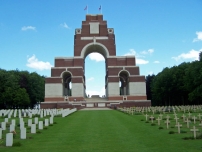| First Name: | Frederick Alfred | Last Name: | BEARD | |
|---|---|---|---|---|
| Date of Death: | 07/10/1916 | Lived/Born In: | Clapton | |
| Rank: | Rifleman | Unit: | King's Royal Rifle Corps12 | |
| Memorial Site: | Thiepval Memorial, France | |||
Current Information:Age-19 64, Median Road, Lower Clapton
The Battle of the Somme (July-November, 1916) By the beginning of October, 1916, the Battle of the Somme had been raging for three months. Thousands of men had already been killed or wounded or were simply missing, never to be seen again and and just a few square miles of the French countryside, all in the southern part of the battlefield, had been captured from the enemy. Mistakes had been made by the various commanders and would be continued to be made but there was no turning back as the British, Australians, South Africans, New Zealanders and Canadians carried on battering away at the German defences in the hope of a breakthrough, So it continued all the way through to November with nearly every battalion and division then in France being drawn into it at some stage. In the end the German trenches had been pushed back a few more miles along most of the line but the cost in lives had been staggering. By the end of the fighting in November, 1916, British Army casualties numbered over 400,000, killed, wounded and missing. The Battle of Transloy Ridge On 1st October, 1916, a new offensive was begun by the British Army. The Battle of Transloy Ridge was the last major operation fought during the battle of the Somme and it continued throughout the first three weeks of the month until the terrible conditions of rain, mud and cold coupled with the sheer exhaustion of the troops, brought things to a standstill. The aim had been to push the enemy further back to the next ridge of higher ground running between Le Transloy and Warlencourt. It was a very hard fight, progress was painfully slow, the casualty figure was shockingly high and the final objective was not achieved despite the best efforts of the attacking divisions. Three factors worked against its success. The first was the weather. It was simply awful. The second was the miles of war torn terrain which soon became a quagmire over which troops, guns, ammunition and all the other supplies had to cross to reach the front and keep the momentum of the offensive going. For the Germans, falling back on their own supply lines across relatively unscathed ground, this was not such a problem. The third factor was the new methods of defence employed by the enemy. They defended in depth without a well defined front line but instead setting up machine-gun nests in shell holes and other strategically important sites where just a few men could hold up an entire battalion. And of course, the German artillery had the whole area covered. On 7th October, 1916, the British Army attacked on a wide front stretching from Lesboeufs, where the British line met the French, to Le Sars on the Albert to Bapaume road. It was not a great success. Very little ground was gained and the cost in casualties was extremely high. 20th Division advanced in the direction of Beaulencourt with the village of Guedecourt on their left and with the task of pushing forward to obtain a position that would be suitable to launch another large scale operation sometime in the future. The attack by 60 Brigade at 1.45pm was made by the 12th Rifle Brigade and 6th Oxford & Buckingham Light Infantry Battalions, supported by 12th King’s Royal Rifle Corps. Things did not get off to a good start when early in the morning a German plane spotted the concentration of British troops in their assembly trenches and as a result a heavy artillery bombardment fell on them and to their rear. At 1.45pm the two leading companies of both battalions went forward with their objective being to capture Rainbow Trench, the enemy front line, at which stage the rest of the battalion would pass through, lie down in front and then follow the barrage to the second objective, Cloudy Trench. This was achieved, not without difficulty, and 20th Division’s attack was the only successful one on the Fourth Army front on this day. As soon as the leading battalions left their own front line, this was then occupied by two companies of 12th King’s Royal Rifle Corps and as the battle progressed they then moved forward to occupy part of Rainbow Trench. However the enemy artillery response was fierce and 12th King’s Royal Rifle Corps sustained ninety casualties throughout the course of the day. Twenty of these came that evening when men from the other two companies were hit by shellfire while part of carrying parties bringing supplies up to the front line. One of the battalion’s casualties on 7th October was Frederick Beard. |
||||
| « Back to Search Results | ||||
| If you think any of the information shown here is incorrect, Click Here to submit your amends and comments | ||||




